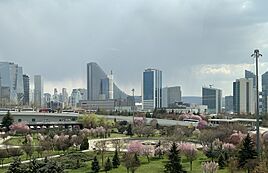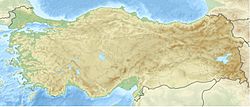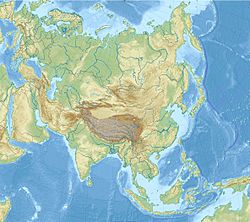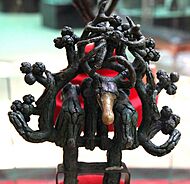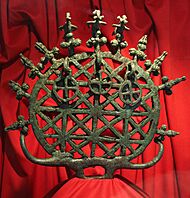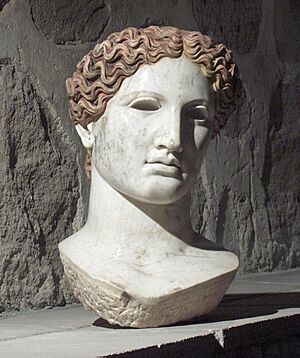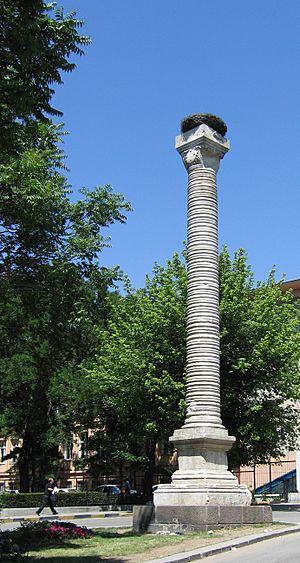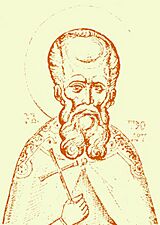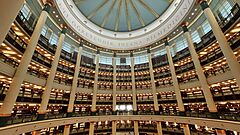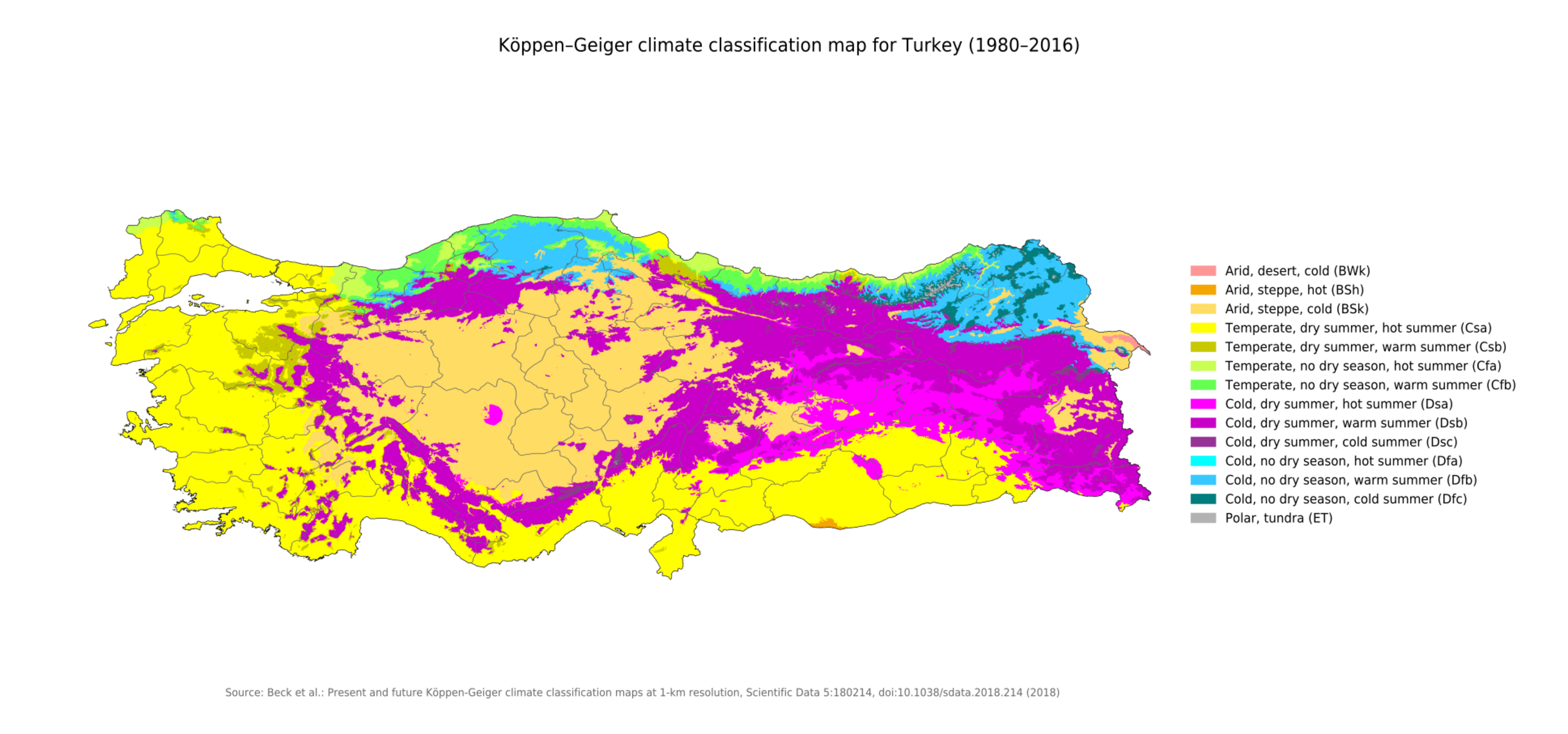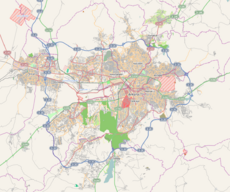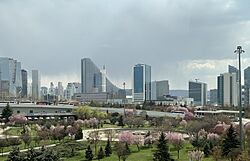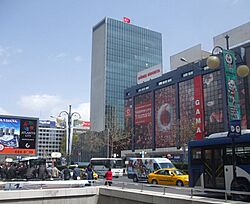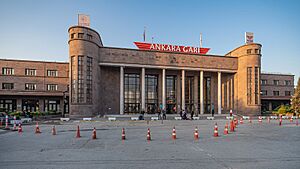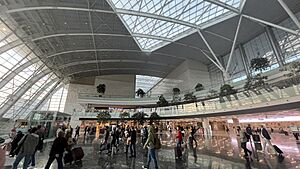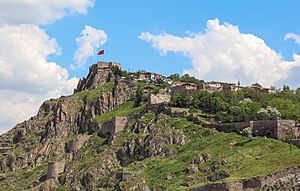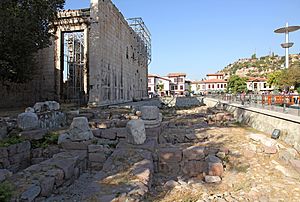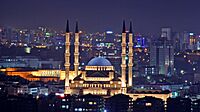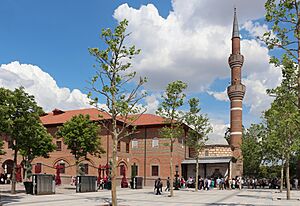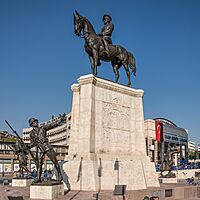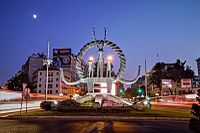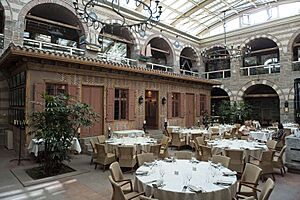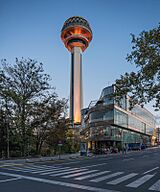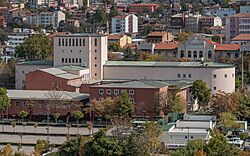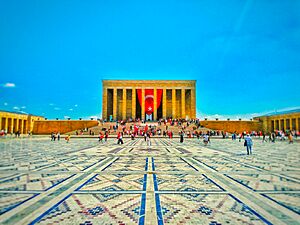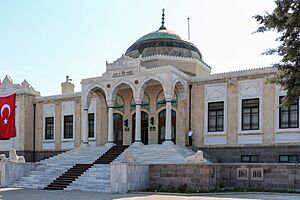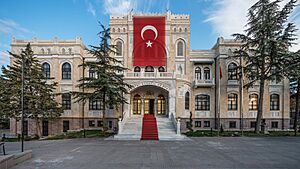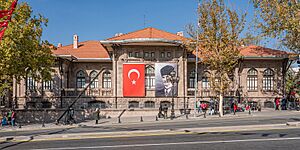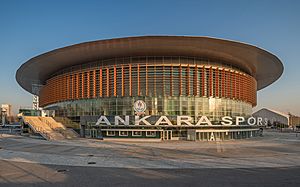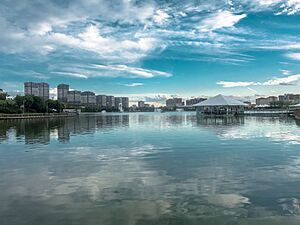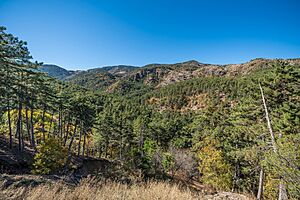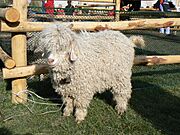Ankara facts for kids
Quick facts for kids
Ankara
|
|||
|---|---|---|---|
|
Capital city and metropolitan municipality
|
|||
|
Söğütözü business district
Atakule Tower
Anıtkabir
Kocatepe Mosque
Presidential Library
|
|||
|
|||
| Nickname(s):
Heart of Turkey
(Turkish: Türkiye'nin Kalbi) |
|||
| Country | |||
| Region | Central Anatolia | ||
| Province | Ankara | ||
| Districts | 25 | ||
| Area | |||
| • Urban | 4,130.2 km2 (1,594.7 sq mi) | ||
| • Metro | 24,521 km2 (9,468 sq mi) | ||
| Elevation | 938 m (3,077 ft) | ||
| Population
(31 December 2023)
|
|||
| • Capital city and metropolitan municipality | 5,803,482 | ||
| • Rank | 2nd in Turkey | ||
| • Urban | 5,165,783 | ||
| • Urban density | 1,251/km2 (3,240/sq mi) | ||
| • Metro density | 237/km2 (610/sq mi) | ||
| Demonym(s) | Ankaran (Turkish: Ankaralı) |
||
| GDP (nominal, 2022) | |||
| • Capital city and metropolitan municipality | ₺ 1,330 billion US$ 81 billion |
||
| • Per capita | ₺ 230,677 US$ 13,919 |
||
| Time zone | UTC+3 (TRT) | ||
| Postal code |
06xxx
|
||
| Area code(s) | +90 312 | ||
| Vehicle registration | 06 | ||
| Website | |||
Ankara is the capital city of Turkey. It is located in the central part of Anatolia. The city has about 5.1 million people in its main urban area. When you include the wider Ankara Province, the population is around 5.8 million. This makes Ankara Turkey's second-largest city, right after Istanbul. However, it is the largest by urban area, covering 4,130 square kilometers.
Ankara has a very long history. It was once the capital of the ancient Celtic state of Galatia. Later, it became a Roman province. You can find many old sites from different civilizations here. These include Hattian, Hittite, Lydian, Phrygian, Galatian, Greek, Persian, Roman, Byzantine, and Ottoman times.
The historic center of Ankara is on a rocky hill. This hill rises about 150 meters (490 feet) above the Ankara River. The ruins of Ankara Castle still sit on top of this hill. Even though many old structures are gone, you can still see well-preserved examples of Roman architecture and Ottoman architecture. A famous example is the Temple of Augustus and Rome. It has an important inscription called the Monumentum Ancyranum.
On April 23, 1920, the Grand National Assembly of Turkey was created in Ankara. This made Ankara the center of the Turkish National Movement during the Turkish War of Independence. Ankara officially became the new capital of Turkey on October 29, 1923. This happened after the Ottoman Empire ended.
Today, the government is a big employer in Ankara. But Ankara is also a major city for business and industry. It is a central point for Turkey's roads and railways. The city is famous for the Angora wool from Angora rabbits and mohair from Angora goats. It also gave its name to the Angora cat. The area is known for its pears, honey, and Muscat grapes. Ankara is considered a green city because it has many green areas per person.
Contents
- What's in a Name? The Meaning of Ankara
- A Look at Ankara's Long History
- Ankara's Location and Weather
- People of Ankara: Demographics
- Ankara's Economy and Business
- Getting Around Ankara
- What to See in Ankara
- Shopping in Ankara
- Ankara's Culture and Arts
- The Arts: Music and Theater
- Museums: Exploring History and Art
- Museum of Anatolian Civilizations: Ancient Treasures
- Anıtkabir: Atatürk's Mausoleum
- Ankara Ethnography Museum: Turkish Culture
- State Art and Sculpture Museum: Turkish Art
- War of Independence Museum: A Nation's Birth
- TCDD Open Air Steam Locomotive Museum: Old Trains
- Ankara Aviation Museum: Planes and History
- Sports in Ankara
- Parks and Green Spaces
- Education: Universities in Ankara
- Animals of Ankara
- International Connections
- See also
What's in a Name? The Meaning of Ankara
The name Ankara has changed over time. Some think it comes from the Hittite word Ankuwaš. In ancient Greek and Latin, the city was called Ánkyra or Ancyra. This name means "anchor".
After the Seljuk Turks took over in 1073, many European languages called the city Angora. The old name "Angora" is still used for certain animal breeds. You might know the Angora rabbit or Angora cat.
A Look at Ankara's Long History
Ankara's history goes back to the Bronze Age with the Hattic civilization. Later, the Hittites took over. After that came the Phrygians, Lydians, Persians, Greeks, Galatians, Romans, Byzantines, and finally the Turks.
Ancient Times: Early Settlements
The first settlements in Ankara were by the Hattians in the Bronze Age. The city grew a lot under the Phrygians around 1000 BC. This happened after an earthquake damaged their capital, Gordion. The Phrygian King Midas was thought to have founded Ancyra. But it was actually much older.
Later, the Lydians and then the Persians ruled. But the Phrygian people stayed strong. Alexander the Great conquered the city in 333 BC. After his death, Ankara became part of Antigonus's empire.
Around 300 BC, the Greeks from Pontos helped Ankara grow. It became a major trading center. Goods moved between the Black Sea ports, Assyria, Cyprus, Lebanon, Georgia, Armenia, and Persia. This is when the city got its Greek name, Ánkyra, meaning "anchor".
Celtic Rule: The Galatians
In 278 BC, a Celtic group called the Galatians took over central Anatolia. They made Ankara one of their main centers. The city was known as Ancyra then. The Celts were a small group of warriors who ruled over the local Phrygian people. The Celtic language was spoken in Galatia for many centuries.
Roman Rule: A Grand Metropolis
The city later came under the Roman Empire. In 25 BC, Emperor Augustus made Ancyra the capital of the new Roman province of Galatia. Ankara is famous for the Monumentum Ancyranum. This temple has a copy of Augustus's life story, called the Res Gestae Divi Augusti. You can still see parts of Roman buildings and inscriptions today.
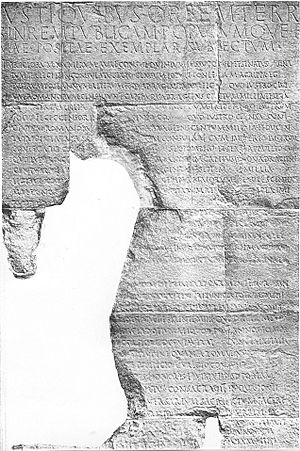
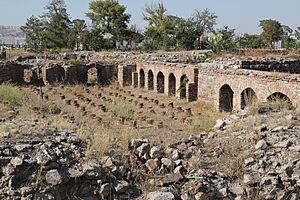
About 200,000 people lived in Ancyra during Roman times. This was a much larger number than in later centuries. The small Ankara River flowed through the city center. Ankara was important because it was a crossroads for major roads. These roads connected northern Anatolia, making it a key location for Rome's eastern border.
In the 3rd century, invaders like the Goths and Arabs attacked Ancyra. For a short time, it was even part of Queen Zenobia's empire from the Syrian Desert. Emperor Aurelian brought it back into the Roman Empire in 272 AD. Roman Ancyra was a big market and trading center. It was also an important administrative capital.
Byzantine Era: A Christian City
In the 4th century, Ankara became a major center for Christians. Many emperors visited the city. Bishops like Marcellus of Ancyra and Basil of Ancyra were important in church discussions. The city hosted three church meetings, called synods, in 314, 358, and 375.
Early Christians in Ankara faced tough times. Bishop Clement was martyred in 303 AD. The remains of the church of St. Clement can still be seen today. After these persecutions, Christianity grew strong in Ankara. The city became known for its monks, priests, and religious debates.
In 362, Emperor Julian visited Ankara. A column was built to honor his visit, and it still stands today. In the late 4th century, Ankara became a summer retreat for emperors. They would escape the humid weather of Constantinople for Ankara's drier mountain air.
The city was attacked by the Sassanid Persians in 620 or 622. Later, in 654, the Arabs captured it for the first time. Ankara was attacked many times by Arab forces over the centuries. In 838, the city was destroyed by the armies of Caliph al-Mu'tasim. But its walls were rebuilt.
Seljuk and Ottoman Times
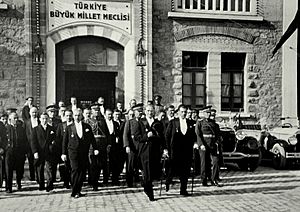
After the Battle of Manzikert in 1071, the Seljuk Turks took over much of Anatolia. Ankara was captured by 1073. In 1101, Crusaders briefly took the city and gave it to the Byzantine emperor. But it soon returned to Seljuk control.
After the Mongols defeated the Seljuks in 1243, a group of craftsmen called Ahiler made Ankara their own independent city-state in 1290. Orhan, the second leader of the Ottoman Empire, captured Ankara in 1356. Timur defeated Bayezid I at the Battle of Ankara in 1402, taking the city. But by 1403, Ankara was back under Ottoman rule.
In the 19th century, Ankara had a population of 20,000 to 60,000 people. It was connected to Istanbul by railway before World War I.
Turkey's Capital: A New Beginning
After the Ottoman Empire lost World War I, much of Turkey was occupied. Mustafa Kemal Atatürk, the leader of the Turkish nationalist movement, set up his resistance headquarters in Angora in 1920. After the Turkish War of Independence was won, the Republic of Turkey was founded on October 29, 1923. Just a few days before, on October 13, 1923, Angora officially became the new capital, replacing Istanbul. Its name was then changed to Ankara.
Ankara grew very quickly after becoming the capital. It was divided into an old section, Ulus, and a new section, Yenişehir. Ulus has ancient buildings and narrow streets. Yenişehir, around Kızılay Square, is modern with wide streets, hotels, and shopping malls.
Government offices and foreign embassies are in the new part of the city. In 1924, Ankara had about 35,000 people. By 1950, it had grown to 286,781. Ankara continued to grow fast and became Turkey's second-largest city after Istanbul. The Presidential Palace is also located in Ankara.
Ankara's Location and Weather
Ankara is in the middle of Turkey, between the Kızılırmak and Sakarya rivers. The Sakarya River forms its western border. Ankara is in the Central Anatolia Region. The Çubuk Brook flows through the city center. It joins the Ankara River, which flows into the Sakarya River.
Climate: Hot Summers, Snowy Winters
Ankara has a cold semi-arid climate. This means it has cold, snowy winters and hot, dry summers. Most rain falls in spring and autumn. The average yearly rainfall is about 414 millimeters (16.3 inches). Temperatures range from 0.9°C (33.6°F) in January to 24.3°C (75.7°F) in July. The yearly average is 12.6°C (54.7°F).
| Climate data for Ankara (Turkish State Meteorological Service Compound, Keçiören), 1991–2020, extremes 1927–2021 | |||||||||||||
|---|---|---|---|---|---|---|---|---|---|---|---|---|---|
| Month | Jan | Feb | Mar | Apr | May | Jun | Jul | Aug | Sep | Oct | Nov | Dec | Year |
| Record high °C (°F) | 18.4 (65.1) |
21.3 (70.3) |
27.8 (82.0) |
31.6 (88.9) |
34.4 (93.9) |
37.0 (98.6) |
41.0 (105.8) |
40.4 (104.7) |
39.1 (102.4) |
33.3 (91.9) |
24.7 (76.5) |
20.4 (68.7) |
41.0 (105.8) |
| Mean daily maximum °C (°F) | 4.7 (40.5) |
7.4 (45.3) |
12.2 (54.0) |
17.5 (63.5) |
22.8 (73.0) |
27.3 (81.1) |
31.0 (87.8) |
31.0 (87.8) |
26.5 (79.7) |
20.3 (68.5) |
13.0 (55.4) |
6.7 (44.1) |
18.4 (65.1) |
| Daily mean °C (°F) | 0.9 (33.6) |
2.7 (36.9) |
6.7 (44.1) |
11.5 (52.7) |
16.5 (61.7) |
20.6 (69.1) |
24.2 (75.6) |
24.3 (75.7) |
19.6 (67.3) |
13.9 (57.0) |
7.3 (45.1) |
2.8 (37.0) |
12.6 (54.7) |
| Mean daily minimum °C (°F) | −2.2 (28.0) |
−1.2 (29.8) |
1.9 (35.4) |
6.0 (42.8) |
10.5 (50.9) |
14.1 (57.4) |
17.2 (63.0) |
17.4 (63.3) |
13.1 (55.6) |
8.4 (47.1) |
2.7 (36.9) |
−0.3 (31.5) |
7.3 (45.1) |
| Record low °C (°F) | −24.9 (−12.8) |
−24.2 (−11.6) |
−19.2 (−2.6) |
−7.2 (19.0) |
−1.6 (29.1) |
3.8 (38.8) |
4.5 (40.1) |
5.5 (41.9) |
−1.5 (29.3) |
−9.8 (14.4) |
−17.5 (0.5) |
−24.2 (−11.6) |
−24.9 (−12.8) |
| Average precipitation mm (inches) | 38.6 (1.52) |
36.6 (1.44) |
46.9 (1.85) |
44.5 (1.75) |
51.0 (2.01) |
40.2 (1.58) |
14.8 (0.58) |
14.6 (0.57) |
17.9 (0.70) |
33.4 (1.31) |
31.9 (1.26) |
43.2 (1.70) |
413.6 (16.28) |
| Average precipitation days | 13.60 | 12.67 | 13.87 | 13.40 | 14.53 | 11.47 | 4.60 | 5.10 | 5.50 | 9.23 | 8.93 | 14.00 | 126.9 |
| Average relative humidity (%) | 76.7 | 70.7 | 63.2 | 58.4 | 56.3 | 53.1 | 45.5 | 45.3 | 48.8 | 60.2 | 68.6 | 76.7 | 60.2 |
| Mean monthly sunshine hours | 68.2 | 101.7 | 148.8 | 189.0 | 238.7 | 279.0 | 328.6 | 316.2 | 264.0 | 195.3 | 129.0 | 74.4 | 2,332.9 |
| Mean daily sunshine hours | 2.2 | 3.6 | 4.8 | 6.3 | 7.7 | 9.3 | 10.6 | 10.2 | 8.8 | 6.3 | 4.3 | 2.4 | 6.4 |
| Source 1: Turkish State Meteorological Service | |||||||||||||
| Source 2: NOAA (humidity, 1991–2020) | |||||||||||||
People of Ankara: Demographics
| Historical population | ||
|---|---|---|
| Year | Pop. | ±% p.a. |
| 2007 | 4,466,756 | — |
| 2012 | 4,965,542 | +2.14% |
| 2017 | 5,445,026 | +1.86% |
| 2022 | 5,782,285 | +1.21% |
| Source: TÜİK | ||
In 1927, Ankara had 75,000 people. By 2022, the population of Ankara Province was 5,782,285. When Ankara became the capital, it was planned for 500,000 people. But it grew much faster than expected. Many people moved from the countryside to the city looking for jobs. This led to many unplanned houses being built.
However, many of these unplanned houses are now being replaced. Large apartment buildings and housing complexes are being built. Ankara Province has a high literacy rate, with 98.18% of people aged 15 or older being able to read and write. It also has the highest percentage of university graduates in Turkey.
Ankara's Economy and Business
Ankara has always been a good farming area. In Ottoman times, it was known for grain, cotton, and fruits. The city has exported mohair (from the Angora goat) and Angora wool (from the Angora rabbit) for centuries. In the 19th century, it also exported animal skins, gum, beeswax, honey, and berries.
The Central Anatolia Region is a main area for grape and wine production. Ankara is famous for its Kalecik Karası and Muscat grapes. It is also known for its pears and a special light-colored honey.
Ankara is a big center for Turkey's defense and aerospace companies. Many large firms like Turkish Aerospace Industries and ASELSAN are here. Exports from these companies have grown a lot. Global car companies like MAN SE also have factories in Ankara. The OSTIM Industrial Zone in Ankara is Turkey's largest industrial park.
Many jobs in Ankara are with government offices and ministries. There are also many foreign diplomats working in embassies.
Getting Around Ankara
The city's public transport is run by EGO. This includes the Ankara Metro and buses. Ankara has a suburban train called Başkentray and five Metro lines. About 400,000 people use these every day. A gondola lift connects the Şentepe district to the Yenimahalle metro station.
The Ankara Central Station is a major train hub. The Turkish State Railways runs passenger trains to other big cities like Istanbul and Izmir. High-speed train services also connect Ankara to Eskişehir, Konya, and Istanbul.
Esenboğa International Airport is Ankara's main airport. It is located northeast of the city.
Public Transportation Facts
On a weekday, people in Ankara spend about 71 minutes using public transit. About 17% of passengers ride for more than two hours daily. People wait about 16 minutes at a stop or station. The average distance traveled in one trip is 9.9 kilometers (6.2 miles).
What to See in Ankara
Ancient and Archeological Sites
Ankara Citadel: A Historic Fortress
The Ankara castle and citadel was first built by the Galatians. The Romans finished it, and the Byzantines and Seljuks later repaired it. The area around the citadel is the oldest part of Ankara. It has many beautiful old buildings. You can find restaurants serving local food in restored traditional Turkish houses inside the citadel. The citadel has been shown on Turkish banknotes.
Roman Theater: Ancient Entertainment
You can see the remains of the Roman theater outside the castle. Roman statues found here are now in the Museum of Anatolian Civilizations. The seating area is still being dug up by archeologists.
Temple of Augustus and Rome: A Roman Legacy
The Temple of Augustus and Rome was built around 25-20 BC. This was after the Romans conquered Central Anatolia. Ankara became the capital of the new Roman province of Galatia. After Emperor Augustus died, a copy of his life story, the Res Gestae Divi Augusti, was carved into the temple walls. The temple was made into a church in the 5th century. It is in the Ulus area of the city.
Roman Baths: Ancient Spa
The Roman Baths of Ankara have all the parts of a typical Roman bath. These include a cold room, a warm room, and a hot room. The baths were built in the early 3rd century by Emperor Caracalla. They honored Asclepius, the God of Medicine. Today, only the lower floors remain. They are also in the Ulus area.
Roman Road: A Path Through History
The Roman Road of Ankara was found in 1995. It is 216 meters (709 feet) long and 6.7 meters (22 feet) wide. Many old items were found along the road. Most of them are now in the Museum of Anatolian Civilizations.
Column of Julian: An Emperor's Visit
The Column of Julian is in the Ulus district. It was built to honor the Roman emperor Julian the Apostate's visit to Ancyra in 362 AD.
Mosques: Beautiful Places of Worship
Kocatepe Mosque: A City Landmark
Kocatepe Mosque is the largest mosque in Ankara. It was built between 1967 and 1987. It has a classical Ottoman style with four tall minarets. Its size and location make it a famous landmark.
Ahmet Hamdi Akseki Mosque: Modern Beauty
Ahmet Hamdi Akseki Mosque is a large, new mosque. It was finished in 2013. It can hold 6,000 people for regular prayers. The mosque has patterns from the Anatolian Seljuk style.
Hacı Bayram Mosque: A Historic Site
This mosque is in the Ulus area, next to the Temple of Augustus. It was built in the early 15th century in Seljuk style. It was later restored by the famous architect Mimar Sinan. The mosque honors Hacı Bayram-ı Veli, whose tomb is next to it.
Modern Monuments: Symbols of Today
Victory Monument: Honoring Atatürk
The Victory Monument was made by Austrian sculptor Heinrich Krippel in 1925. It was put up in 1927 at Ulus Square. It has a statue of Mustafa Kemal Atatürk on a horse.
Statue of Atatürk: A Leader's Image
This statue is at Zafer (Victory) Square. It was made by Italian sculptor Pietro Canonica in 1927. It shows Atatürk standing in a modern military uniform.
Monument to a Secure, Confident Future
This monument is in Güvenpark near Kızılay Square. It was built in 1935. It has Atatürk's advice: "Turk! Be proud, work hard, and believe in yourself."
Hatti Monument: Ancient Roots
This monument was put up in 1978 at Sıhhiye Square. It shows the Hatti Sun Disc. This symbol remembers Anatolia's oldest known civilization. The Hatti Sun Disc has been used in Ankara's city logo.
Inns: Historic Caravanserais
Suluhan: An Old Trading Stop
Suluhan is a historic inn in Ankara. It was built between 1508 and 1511. It has 102 rooms, which are now shops. These rooms face two courtyards.
Çengelhan Rahmi M. Koç Museum: Industrial History
Çengelhan Rahmi M. Koç Museum is a museum of industrial technology. It is in Çengel Han, an Ottoman-era inn built in 1523. The museum shows industrial items from the 1850s onwards. It also has sections about Mustafa Kemal Atatürk and Ankara city.
Shopping in Ankara
Visitors often enjoy the old shops in Çıkrıkçılar Yokuşu (Weavers' Road) near Ulus. Here you can find traditional fabrics, carpets, and leather goods. Bakırcılar Çarşısı (Bazaar of Coppersmiths) is popular for jewelry, antiques, and embroidery. Near the castle gate, you can find spices, dried fruits, and nuts.
Modern shopping areas are in Kızılay and on Tunalı Hilmi Avenue. These include the Karum mall. Atakule Tower in Çankaya has great views of Ankara. It also has a revolving restaurant at the top. The Armada Shopping Mall has an anchor symbol. This is a nod to Ankara's ancient Greek name, Ánkyra, which means "anchor".
Many modern malls are located along the western highway, also known as the Eskişehir Road. These include Armada, CEPA, and Kentpark. The ANKAmall on the Istanbul Highway is the largest mall in the Ankara region. More malls like Next Level and Taurus opened in 2014.
Ankara's Culture and Arts
The Arts: Music and Theater
The Turkish State Opera and Ballet has its main office in Ankara. The city has three venues for opera and ballet. Ankara is home to five classical music orchestras. These include the Presidential Symphony Orchestra and the Bilkent Symphony Orchestra.
There are four concert halls in the city. These are the CSO Concert Hall, Bilkent Concert Hall, MEB Şura Salonu, and Çankaya Çağdaş Sanatlar Merkezi Concert Hall. Ankara also hosts annual theater, music, and film festivals. The Ankara International Music Festival presents classical music and ballet.
The Turkish State Theatres also has its main office in Ankara. It runs several stages in the city. There are also private theater companies.
Museums: Exploring History and Art
Ankara has about 50 museums.
Museum of Anatolian Civilizations: Ancient Treasures
The Museum of Anatolian Civilizations is near the Ankara Castle. It is in an old 15th-century covered market. It has collections from the Paleolithic, Neolithic, Hatti, Hittite, Phrygian, Urartian, and Roman periods. It also has a large section of Lydian treasures.
Anıtkabir: Atatürk's Mausoleum
Anıtkabir is on a large hill called Anıttepe. It is the mausoleum of Mustafa Kemal Atatürk, who founded the Republic of Turkey. It was finished in 1953. It mixes old and modern architectural styles. A museum next to it has Atatürk's wax statue, writings, and personal items. It also shows photos from his life and the founding of the Republic.
Ankara Ethnography Museum: Turkish Culture
The Ankara Ethnography Museum is in the Ulus district. It has a collection of traditional Turkish items. It also has artifacts from the Seljuk and Ottoman periods. In front of the museum, there is a statue of Mustafa Kemal Atatürk.
State Art and Sculpture Museum: Turkish Art
The State Art and Sculpture Museum opened in 1980. It has a rich collection of Turkish art from the late 19th century to today. It also hosts special art exhibitions.
War of Independence Museum: A Nation's Birth
The War of Independence Museum is in Ulus Square. It was the first Parliament building of the Republic of Turkey. The War of Independence was planned here. You can see photos and items from that time. There are also wax figures of former Turkish presidents.
TCDD Open Air Steam Locomotive Museum: Old Trains
The TCDD Open Air Steam Locomotive Museum is an outdoor museum. It shows the history of steam locomotives.
Ankara Aviation Museum: Planes and History
Ankara Aviation Museum is near the Istanbul Road. It opened in 1998. It has missiles, aviation materials, and aircraft. These include planes that served in the Turkish Air Force.
Sports in Ankara
Football is the most popular sport in Ankara. The city has one football club, Ankaragücü, in the top Turkish league. They are the oldest club in Ankara. Gençlerbirliği also plays in a high league.
In basketball, Türk Telekom B.K. represents Ankara in the Turkish Basketball Super League. They play at the Ankara Arena.
Halkbank Ankara is a top men's volleyball team. They have won many championships.
The Ankara Buz Pateni Sarayı is where ice skating and ice hockey competitions happen. Skateboarding is also popular in the city. Skaters often meet near the Grand National Assembly of Turkey.
Parks and Green Spaces
Ankara has many parks and green areas. Many were created when the Republic was founded. Some important parks are:
- Gençlik Parkı: It has an amusement park and a pond for rowing.
- Seğmenler Park
- Kuğulu Park: Famous for its swans, a gift from China.
- Kurtuluş Park: It has an ice-skating rink.
- Altınpark: A large exhibition area.
- Harikalar Diyarı: Said to be Europe's biggest park within city limits.
- Göksu Park.
Atatürk Forest Farm and Zoo is a huge recreational area. It has a zoo, farms, restaurants, and a brewery. It's a great place for picnics, hiking, or just enjoying nature. There's also a copy of the house where Atatürk was born. Visitors can try famous farm products like old-fashioned beer and ice cream.
Education: Universities in Ankara
Ankara is known for its many universities. Several of them are among the best in Turkey. These include:
- Ankara University
- Bilkent University
- Hacettepe University
- Middle East Technical University
- TOBB University of Economics and Technology
- Yıldırım Beyazıt University
Animals of Ankara
Angora Cat: A Famous Feline

Ankara is home to the world-famous Turkish Angora cat breed. In Turkish, it's called Ankara kedisi. These cats are one of the oldest natural cat breeds. They come from Ankara and the surrounding area.
They usually have white, silky, long fur. They don't have an undercoat. Their eyes can be blue, green, amber, or even one blue and one amber. Sometimes, blue-eyed white cats can be deaf on the side of the blue eye. But many have normal hearing. Angora cats have pointed ears and almond-shaped eyes. Their tail is often held parallel to their back.
Angora Goat: Source of Mohair
The Angora goat also comes from Ankara and central Anatolia. This breed was first mentioned around 1500 BC. The first Angora goats came to Europe in 1554.
The soft fiber from an Angora goat is called mohair. One goat can produce 5 to 8 kilograms (11 to 18 pounds) of hair each year. Angoras are shorn twice a year. The United States, Turkey, and South Africa are the top producers of mohair. Angora goats were first bred for their white coats. But now, they also produce black, red, and brownish fiber. Angora goats were shown on Turkish banknotes.
Angora Rabbit: Fluffy and Soft
The Angora rabbit is bred for its long, soft hair. It is one of the oldest types of domestic rabbits. It also comes from Ankara, just like the Angora cat and goat. These rabbits were popular pets with French royalty in the 1700s.
Angoras are mostly bred for their wool, which is very silky and soft. They look like a ball of fur. They are usually calm and gentle. Their fur needs regular grooming to prevent tangles. Sometimes, they are shorn in the summer to keep them from getting too hot.
International Connections
Twin Towns and Sister Cities
Ankara is connected with many cities around the world. These are called twin towns or sister cities.
 Seoul, South Korea (since 1971)
Seoul, South Korea (since 1971) Islamabad, Pakistan (since 1982)
Islamabad, Pakistan (since 1982) Kuala Lumpur, Malaysia (since 1984)
Kuala Lumpur, Malaysia (since 1984) Beijing, China (since 1990)
Beijing, China (since 1990) Amman, Jordan (since 1992)
Amman, Jordan (since 1992) Bishkek, Kyrgyzstan (since 1992)
Bishkek, Kyrgyzstan (since 1992) Budapest, Hungary (since 1992)
Budapest, Hungary (since 1992) Khartoum, Sudan (since 1992)
Khartoum, Sudan (since 1992) Moscow, Russia (since 1992)
Moscow, Russia (since 1992) Sofia, Bulgaria (since 1992)
Sofia, Bulgaria (since 1992) Havana, Cuba (since 1993)
Havana, Cuba (since 1993) Kyiv, Ukraine (since 1993)
Kyiv, Ukraine (since 1993) Ashgabat, Turkmenistan (since 1994)
Ashgabat, Turkmenistan (since 1994) Kuwait City, Kuwait (since 1994)
Kuwait City, Kuwait (since 1994) Sarajevo, Bosnia and Herzegovina (since 1994)
Sarajevo, Bosnia and Herzegovina (since 1994) Tirana, Albania (since 1995)
Tirana, Albania (since 1995) Tbilisi, Georgia (since 1996)
Tbilisi, Georgia (since 1996) Ufa, Bashkortostan, Russia (since 1997)
Ufa, Bashkortostan, Russia (since 1997) Alanya, Turkey
Alanya, Turkey Bucharest, Romania (since 1998)
Bucharest, Romania (since 1998) Hanoi, Vietnam (since 1998)
Hanoi, Vietnam (since 1998) Manama, Bahrain (since 2000)
Manama, Bahrain (since 2000) Mogadishu, Somalia (since 2000)
Mogadishu, Somalia (since 2000) Santiago, Chile (since 2000)
Santiago, Chile (since 2000) Astana, Kazakhstan (since 2001)
Astana, Kazakhstan (since 2001) Dushanbe, Tajikistan (since 2003)
Dushanbe, Tajikistan (since 2003) Kabul, Afghanistan (since 2003)
Kabul, Afghanistan (since 2003) Ulaanbaatar, Mongolia (since 2003)
Ulaanbaatar, Mongolia (since 2003) Cairo, Egypt (since 2004)
Cairo, Egypt (since 2004) Chișinău, Moldova (since 2004)
Chișinău, Moldova (since 2004) Sana'a, Yemen (since 2004)
Sana'a, Yemen (since 2004) Tashkent, Uzbekistan (since 2004)
Tashkent, Uzbekistan (since 2004) Pristina, Kosovo (since 2005)
Pristina, Kosovo (since 2005) Kazan, Tatarstan, Russia (since 2005)
Kazan, Tatarstan, Russia (since 2005) Kinshasa, Democratic Republic of the Congo (since 2005)
Kinshasa, Democratic Republic of the Congo (since 2005) Addis Ababa, Ethiopia (since 2006)
Addis Ababa, Ethiopia (since 2006) Minsk, Belarus (since 2007)
Minsk, Belarus (since 2007) Zagreb, Croatia (since 2008)
Zagreb, Croatia (since 2008) Damascus, Syria (since 2010)
Damascus, Syria (since 2010) Bissau, Guinea-Bissau (since 2011)
Bissau, Guinea-Bissau (since 2011) Washington, D.C., US (since 2011)
Washington, D.C., US (since 2011) Bangkok, Thailand (since 2012)
Bangkok, Thailand (since 2012) Tehran, Iran (since 2013)
Tehran, Iran (since 2013) Doha, Qatar (since 2016)
Doha, Qatar (since 2016) Podgorica, Montenegro (since 7 March 2019)
Podgorica, Montenegro (since 7 March 2019) North Nicosia, Northern Cyprus
North Nicosia, Northern Cyprus Djibouti City, Djibouti (since 2017)
Djibouti City, Djibouti (since 2017)
Partner Cities
See also
 In Spanish: Ankara para niños
In Spanish: Ankara para niños


